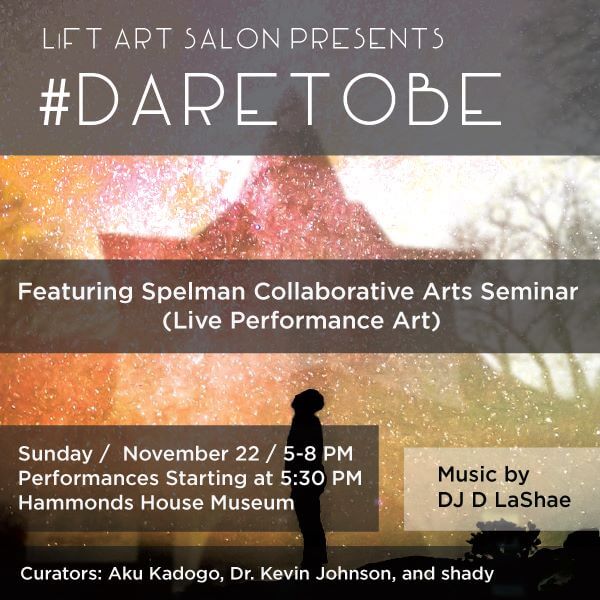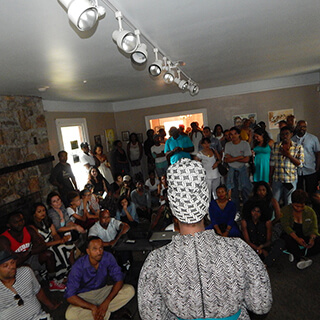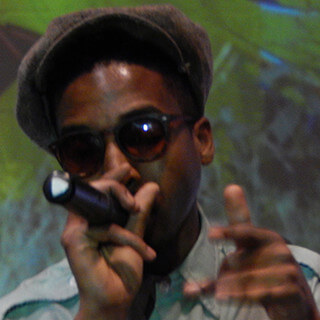Clint and Nasim Mahboubi Fluker co-founded LiFT Art Salon in 2014 as a monthly gathering of young Atlanta professionals, artists, and social activists to mobilize the arts as a community development tool. This place-based salon follows the example of politicians, academics, and activists who worked collaboratively under former Atlanta mayor Maynard Jackson’s administration (1974–1982) to support regional arts institutions. This new blog series features reviews and retrospectives of LiFT gatherings. For more information, visit LiFT Art Salon.

My childhood family vacations included mandatory excursions to museums, libraries, and historical sites. To ensure that my little brother and I "enjoyed" cultural experiences of all stripes, we toured the Smithsonian in Washington, DC, Martin Luther King Jr.'s grave at the King Center in Atlanta, Georgia, and the Boston Children's Museum. Much to my parent's dismay, I was much more interested in playing outside with friends, drawing superheroes, and tormenting my little brother than in appreciating educational tourism.

Today, as a doctoral student in Emory University's Institute for the Liberal Arts, I research contemporary science fiction and fantasy, focusing on the literary and visual cultures of Afrofuturism. My research takes me into the Stuart A. Rose Manuscript, Archives, and Rare Book Library where I read the late twentieth century writings of Octavia Butler, Steven Barnes, and Samuel R. Delany alongside the visual images of early 20th century artists, like Aaron Douglas.
Exploring connections across genres and time periods, as well as class and color lines, I look for imagined black futures in archival holdings. In addition to my research, I work as an assistant curator for the African American Collections in the Rose library, creating programs that connect undergraduates to Emory's archives. My twelve-year-old self would marvel at this transformation: somewhere between grade school and graduate study, I learned to appreciate smelly old books, discolored newspapers, and indecipherable manuscripts. I blame my parents—after all, they planted the seed that is now blossoming into full-blown archive fever.

My scholarly interests and newfound archival passions come together in the monthly LiFT art salons that bring young Atlantans into local museums and historic sites. On November 22nd 2015, LiFT hosted the #DareToBe event at the Hammonds House Museum, a nineteenth-century home that has served as one of Atlanta's premiere institutions of black art since 1988. The #DareToBe event targeted Atlanta University Center (AUC) students, hoping to encourage a substantive dialogue in one Atlanta neighborhood.

The AUC is a collective of Historically Black Colleges and Universities that include Morehouse College, Morehouse School of Medicine, Spelman College, and Clark Atlanta University. While these institutions share West End real estate, close proximity does not necessarily imply longstanding relations between current AUC students and their host neighborhood. On the contrary. During my time as a Morehouse undergraduate, I stayed primarily on campus and rarely connected with the West End or the Atlanta metro region. By hosting #DareToBe at the Hammonds House Museum, LiFT encouraged AUC students to get off campus and to understand themselves within broader networks.

LiFT team members collaborated with two Spelman professors to plan, promote, and stage the gathering. Professor of drama and renowned playwright and dance instructor Aku Kadogo joined forces with Glee Club director Dr. Kevin Johnson to design the fall 2015 "Collaborative Arts" seminar that culminated in LiFT's #DareToBe event. For her final project, each student created a project to perform or feature at the Hammonds House gathering. This creative activity stretched many students beyond their comfort zones, asking them to be artists and creators.
#DareToBe was staged in each room of the Hammonds House, inviting the Spelman students to consider the home's architecture as an active participant in their creative process. With students singing, dancing, and acting across the building's footprint, the museum transformed into a living, breathing art studio. In total, there were four performances: "Mathematical Proof" featured a spoken word performance accompanied by piano and backup vocals. "Chorepoem" cast four Spelman women in an interactive performance celebrating black womanhood. "Karrah 4 Prez" envisioned a black female presidential candidate in a one-act scene. The final performance, "#Daretobe Anthem", brought the entire class together to perform an original song.
For Professor Kadogo, the event extended one Spelman classroom beyond the campus gates:
Connecting our Spelman College students with the historic Hammonds House proved to be an invaluable experience. The Spelman students participated in networking, decision-making, and performance creation. As part of our process, we visited the Hammonds House and toured the entire museum, deciding along with LiFT curator Shady Patterson and event coordinator Miriam Denard where each performance might best be stationed to facilitate a "walking tour" performance event.
Working in collaboration with LiFT, the students gained encouragement and inspiration, realizing that they were creating something that other people wanted to experience.1Aku Kadogo, phone interview with author, March 10th, 2016, Atlanta, Georgia. Transcription by author.
The students' performances generated an energized talk-back with the crowd. During the question and answer session, attendees engaged the students as artists, probing them about their creative process and performance experiences. Many students shared that the LiFT event prompted their first visit to the Hammonds House, signaling to them the importance of historic institutions in their neighborhood and beyond. Event attendees shared similar stories about a lack of familiarity with local museums and cultural institutions.
LiFT Art Salon measures success by the relationships it builds between people, institutions, and their histories, specifically between those spaces that narrate black history and Atlanta's young African American population. I know first-hand that nurturing these relationships takes the time and investment of an engaged community of elders, scholars, and teachers. The LiFT team learned a valuable lesson at #DareToBe. In order to make museums and archives accessible to a new generation, we need to build hands-on, interactive experiences that invite young Atlantans to actively engage the city's diverse centers and institutions. At our monthly gatherings, LiFT attempts to demonstrate to a new constituency that cultural institutions are not merely repositories. Instead, as I am reminded each time I comb the archives or plan a LiFT event , these sites serve as creative commons for those who dare to enter and be.

Similar Publications
| 1. | Aku Kadogo, phone interview with author, March 10th, 2016, Atlanta, Georgia. Transcription by author. |
|---|

